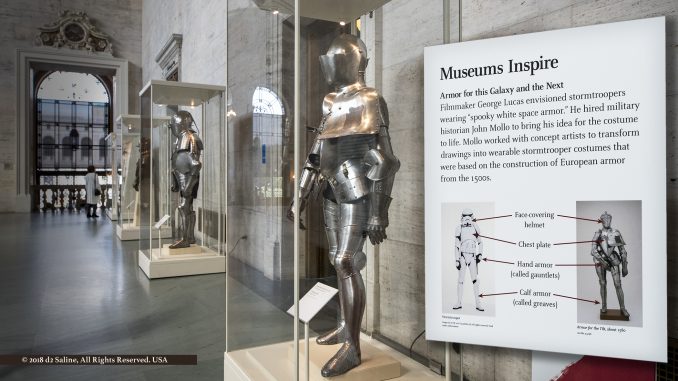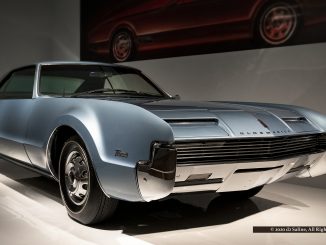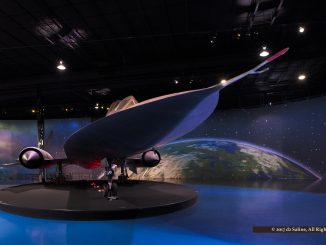
What’s the difference between a museum and a warehouse?
Raiders of the Lost Ark opens with persuit of an artifact destined for display in a museum and closes with the acquisition of a treasure that seems condemned to obscurity in a warehouse. This movie clearly distinguishes one repository as a splendid outcome, the other as very, very bad. The good place is where people engage with historic artifacts. [1]
The challenge here isn’t limited to choosing the right building as repository, of course. Nor is it a matter of devining the histories of such objects — including, often times, the trials and sweat that went into their coming to be, and even the occasional final furlong adventures by which they came to be here on exhibit. Some things come with expectation, with notions preconceived by those who think they’ve already seen and heard everything the stories that will be told in any upcoming public showing, sight unseen.
Such was the challenge faced by the Detroit Institute of Arts (DIA) when it scheduled to host “Star Wars and the Power of Costume” in its galleries this summer. In the US, over 40% of all people see each new Star Wars film upon release. They know the mythos. They know what they are coming to see. [2,3,4,5,6]
No, they do not.
DIA organizers knew that visitors could and would benefit from experiencing Star Wars from the perpective of an art museum, with focus on costumes as process, messaging, and implementation. Convince them to surrender their curiosities to the DIA and their galaxy stood to get a whole lot bigger.
DIA Vice President for Exhibition, Collection, and Information Strategies John Steele sat down with Saline Journal last week to share vision and tactics. This meant both the intrinsic value of what the Smithsonian Institution Traveling Exhibition Service had developed as a foundation in collaboration with the Lucas Museum of Narrative Art, and how his organization built upon that. He started by telling us about the setup he’d seen first-hand about two years earlier, during its second stop, in New York City. [7,8,9]
“We felt we could place those costumes within the context of the creative process,” he told us. “From design through inception.
“That begins with thinking in terms of a visitor-centered experience. What are the big ideas, the outcomes we want them to take away from this? Then we pair a curator with an interpretor, whose job it is to help the public connect with what they are experiencing here in ways that are directed toward planned outcomes. [10,11]
“One of the ways we helped focus on the creative process was to borrow somewhere between sixty and a hundred original drawings that were not a part of the original show. We worked this within the requirements that Lucas Studies did not want to change, and worked very closely with them on approvals all along the way — including the production of special label copy and supporting video.”
Tactically, Melanie Parker served point on interpretation for Star Wars at the Detroit Institute of Arts. “We are focused on creating stories that are more meaningful and relevant,” she told Saline Journal, “not just facts.”
She provided tangible examples of how the unique nature of the DIA as a broader cultural and historical archives was leveraged, reciprocally, with “Star Wars and the Power of Costume.” DIA teams ‘connected’ inspirations for Darth Vador head gear to their Samurai Helmet display, “object for object. Stormtrooper armor was directly based on armor like we have on display from the Medieval period,” she said. [12,13,14]
In other cases, fabrics, color choices, folds, cuts and headdresses can tell you about the importance of royalty and position in society — without having anyone say that. We draw from parallels in our permanent collections to explain what certain costume choices had to say about Queen Amidala.” [15]
More broadly, both Mr Steele and Ms Parker emphasized the larger team that was needed to deliver on projects of this size, typically one- to three-years in the making.
“The layout and feel of the exhibitions can vary depending on the physical space of the building,” Melanie Parker explained in terms of traveling exhibits such as Star Wars.
Certain choices are made by the individual venues …. Those elements, the ‘theatrical’ feel of our exhibition, many of the platforms, lighting decisions, et cetera, are all manifestations of the design team’s work. We work in a collaborative environment, and that’s true from start to finish. The curatorial and interpretive staff work in conjunction with designers and other work teams to build the comprehensive exhibition experience. The DIA’s exhibition designer is Theodora Doulamis; the lighting designer is Marc Langlois; and the graphic designer is Everett Keyser.
Another thing that is somewhat unique to the DIA is the Art Studio and Costume Shop spaces. The Denver Art Museum added these spaces to their version of the exhibition for the first time to evoke the look and feel of creativity at work. We are the only other venue to follow their lead and incorporate similar spaces, and while they work toward the same goal for visitors’ experiences, our spaces do look rather different from theirs. [16]
In summary, John Steele pointed to something too easily overlooked. “Lighting is an art form. Our lighting is integral to overall design. As opposed to (print) art shows, it creates context, sometimes drama. It brings the individual displays to life.”
No one claimed the mantle of Indiana Jones here, of course. But it was interesting to note that their adventure wasn’t limited to a story of the objects and presentation.
Summer is typically the “slow” period for DIA in terms of serving visitors, with a break from school field trips and so many families away for vacations. This year, this exhibit, was a different matter altogether. Bar none, Star Wars has set the record for Detroit Institute of Arts attendance this summer. Staff hit light speed on May 20 with this, and things show no sign of letting up through the end of this month.
And there are still twenty-four days left to make your own connection here.
References
- “Raiders of the Lost Ark (1981)” IMDb.
- Detroit Institute of Arts (home page).
- “Star Wars and the Power of Costume” (May 20, 2018 – September 30, 2018) Detroit Institute of Arts (DIA).
- “Share of adults who have seen Star Wars in the United States as of December 2017, by movie” (2017) Statista.
- “Star Wars Canon Timeline: Where to Start” Megan Crouse, John Saavedra (May 29, 2018) Den of Geek.
- “Part History, Part Fashion, Part Science Fiction: Detroit Marks Final Stop For Must-See Original ‘Star Wars’ Exhibition” Dell Deaton (July 3, 2018) Saline Journal.
- Rebel, Jedi, Princess, Queen: Star Wars and the Power of Costume (home page).
- Smithsonian Institution Traveling Exhibition Service (home page).
- Lucas Museum of Narrative Art (home page).
- National Association for Interpretation (home page).
- Association of Art Museum Interpretation (home page).
- “Darth Vader” Star Wars.
- “Samurai Helmet (Namazu-o Kawari Kabuto), 17th century” Detroit Institute of Arts.
- “Stormtroopers” Star Wars.
- “Queen Amidala’s Couture – Star Wars: Discoveries from the Inside” Star Wars.
- Denver Art Museum (home page).
Hashtags
#starwarscostume
#starwarsDIA



